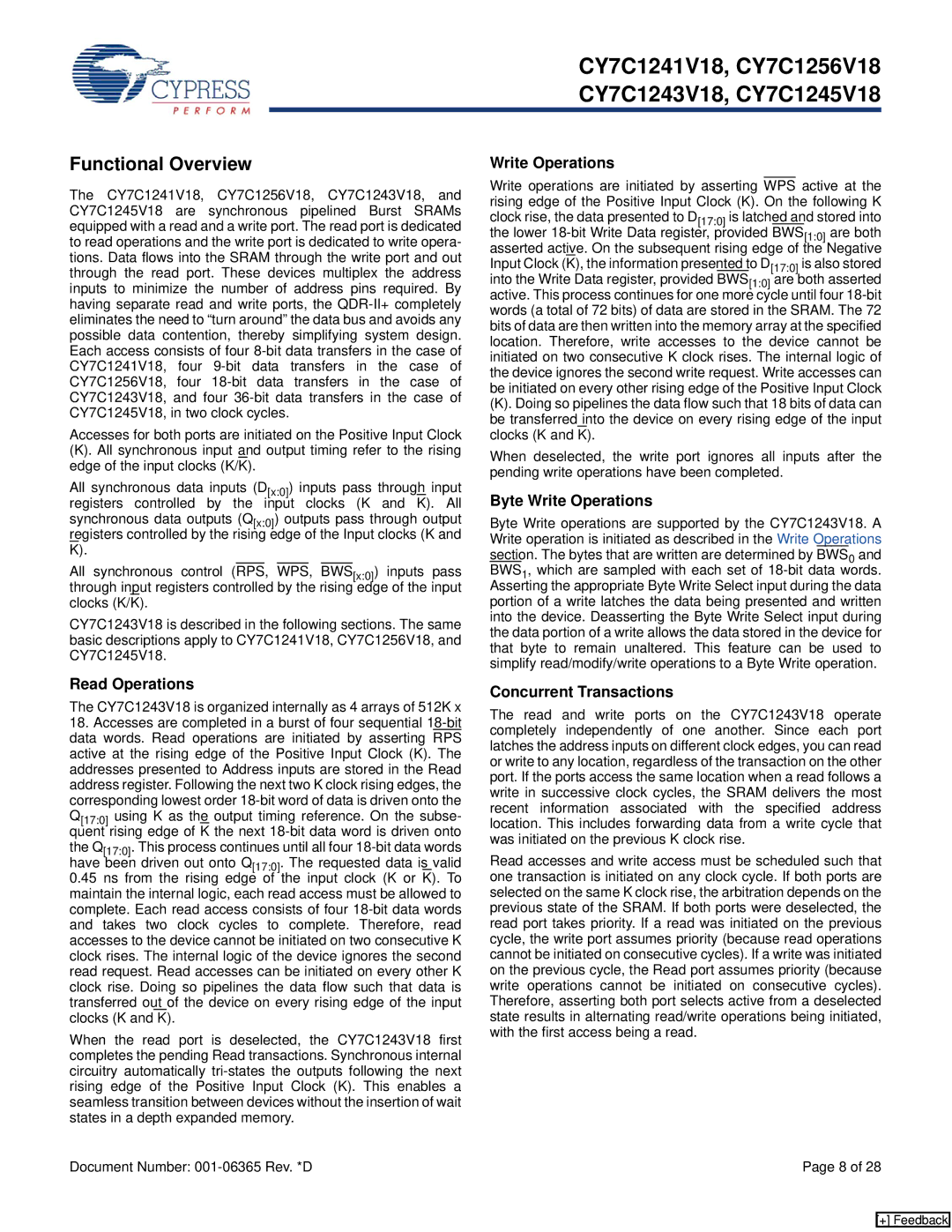
CY7C1241V18, CY7C1256V18 CY7C1243V18, CY7C1245V18
Functional Overview
The CY7C1241V18, CY7C1256V18, CY7C1243V18, and CY7C1245V18 are synchronous pipelined Burst SRAMs equipped with a read and a write port. The read port is dedicated to read operations and the write port is dedicated to write opera- tions. Data flows into the SRAM through the write port and out through the read port. These devices multiplex the address inputs to minimize the number of address pins required. By having separate read and write ports, the
Accesses for both ports are initiated on the Positive Input Clock
(K). All synchronous input and output timing refer to the rising edge of the input clocks (K/K).
All synchronous data inputs (D[x:0]) inputs pass through input registers controlled by the input clocks (K and K). All synchronous data outputs (Q[x:0]) outputs pass through output registers controlled by the rising edge of the Input clocks (K and K).
All synchronous control (RPS, WPS, BWS[x:0]) inputs pass through input registers controlled by the rising edge of the input clocks (K/K).
CY7C1243V18 is described in the following sections. The same basic descriptions apply to CY7C1241V18, CY7C1256V18, and CY7C1245V18.
Write Operations
Write operations are initiated by asserting WPS active at the rising edge of the Positive Input Clock (K). On the following K clock rise, the data presented to D[17:0] is latched and stored into the lower
(K). Doing so pipelines the data flow such that 18 bits of data can be transferred into the device on every rising edge of the input clocks (K and K).
When deselected, the write port ignores all inputs after the pending write operations have been completed.
Byte Write Operations
Byte Write operations are supported by the CY7C1243V18. A Write operation is initiated as described in the Write Operations section. The bytes that are written are determined by BWS0 and BWS1, which are sampled with each set of
Read Operations
The CY7C1243V18 is organized internally as 4 arrays of 512K x
18.Accesses are completed in a burst of four sequential
Q[17:0] using K as the output timing reference. On the subse- quent rising edge of K the next
When the read port is deselected, the CY7C1243V18 first completes the pending Read transactions. Synchronous internal circuitry automatically
Concurrent Transactions
The read and write ports on the CY7C1243V18 operate completely independently of one another. Since each port latches the address inputs on different clock edges, you can read or write to any location, regardless of the transaction on the other port. If the ports access the same location when a read follows a write in successive clock cycles, the SRAM delivers the most recent information associated with the specified address location. This includes forwarding data from a write cycle that was initiated on the previous K clock rise.
Read accesses and write access must be scheduled such that one transaction is initiated on any clock cycle. If both ports are selected on the same K clock rise, the arbitration depends on the previous state of the SRAM. If both ports were deselected, the read port takes priority. If a read was initiated on the previous cycle, the write port assumes priority (because read operations cannot be initiated on consecutive cycles). If a write was initiated on the previous cycle, the Read port assumes priority (because write operations cannot be initiated on consecutive cycles). Therefore, asserting both port selects active from a deselected state results in alternating read/write operations being initiated, with the first access being a read.
Document Number: | Page 8 of 28 |
[+] Feedback
